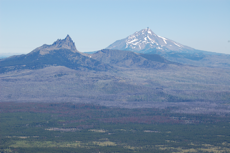


Geography 433/533: Fire and Natural Disturbances
Fall 2023
Office: 254C Columbia; Phone: 346-5787
Office Hours: Wednesdays 10:00-11:30 in Columbia 254C or use the zoom link (in Canvas) to attend remotely.
Lectures: Tuesday and Thursdays, 10:00-11:20, in 189 PLC. |
|
October 13 (Friday); three vans are reserved to view forest and fire ecology across the Cascade Range. We will view the 2020 Labor Day fire (Holiday Farm Fire), forest management in the McKenzie Ranger District, fire of the High Cascades around Santiam Pass, and fire ecology and management in the Sisters Ranger District. This is a long day and the details of the trip will be planned over the summer. Please do what you can to reserve this day. Please let me know if you are van-driver certified, too. |
Course Description: Wildland fire is one of the most important natural disturbances of ecosystems. It is also a disturbance that presents a risk to human society that is difficult to balance among competing interests. This course will serve as an introduction to disturbance ecology with a focus on wildland fire. Fire will be examined at many levels: the weather and fuel conditions that result in a range of fire behaviors, the effects of fire on vegetation and ecosystems, and the history of fire including its connection to long-term climate change. We will study fire as an important process in all of the major biomes, not only the Pacific Northwest. Other natural disturbances to be addressed include wind, insect outbreaks, ice storms, and drought, all of which have synergistic effects with fire. The last portion of the class will address human-caused changes in the landscape of wildfire, including specific management issues of fire in the Pacific Northwest.
Objectives of the course
- Understand the patterns and controls influencing natural disturbances over landscapes and through time.
- Understand the basics of fire behavior and fire effects on species and ecosystems, including adaptations of species to fire.
- Learn the autecology of dominant species in Oregon's forests and their response to fire.
- Examine the historical variability of fire (including the statistical methods to summarize historical variability) in order to place the current fire landscape in a longer-term context.
- Develop an in-depth knowledge in an area of fire science of your choice. Both undergraduates and graduate students will write a final paper. Details will be presented in a separate document (see Canvas pages). The goals of the paper will be to:
- Learn to write for a broad audience a balanced article addressing a clearly defined topic.
- Learn to synthesize data and information from several scientific disciplines
- Address how scientific data are used in the public policy arena, in the context of your topic.
Wikipedia articles related to this course: Fire | Wildfire | Wildfire modeling | Firestorm | Complex_early_seral_forest | Fire_ecology | Disturbance_(ecology) | Patch_dynamics | and several others, for example, on other forms of natural disturbance (landslides, floods (and tropical cyclone-induced flooding), ice storms, insect outbreaks, wind events, beaver activity, drought).
Topics falling outside the scope of this course (and will not be allowable as topics for research papers): Methods of fire management: Wildfire_suppression | Controlled_burn | Fire-adapted_communities. Topics related to fire but not in the context of natural disturbance regimes or ecosystems: for example:Biochar | Smoke and health effects
Modality
This is an in-person course: that means that, unlike asynchronous online/ASYNC WEB courses, we will meet during scheduled class meeting times in (class location). I will accommodate absences as described in the Absences policy below. If you need additional flexibility, UO encourages you to consider ASYNC WEB courses. If you need accommodation related to a medical or other disability, you can request those by working with the Accessible Education Center.
Canvas is the place to go for course information and engagement outside of class time. To access our course Canvas site, log into canvas.uoregon.edu using your DuckID. If you have questions about using Canvas, visit the Canvas support page. Canvas and Technology Support also is available by phone (541-346-4357) or by live chat on the Live Help webpage.
Assessment and percent of total grade:- Field trip report: 15%. A one-page (double-spaced) response to a theme explained at the start of the field trip and discussed on Monday after the trip. Alternative assignments regarding the assigned reading will be given to students who cannot attend the field trip.
- One homework exercise (NEO MODIS hypothesis exploration): 20%
- One exam: 30%. Closed notes. Multiple choice and very-short answers. Graduate students will have 50% fewer multiple-choice questions and will have short-answer questions allowing for a longer written answer.
- Research paper (tasks distributed throughout term): 35%
- Geog 433: Case-study assignment
- Geog 533: A literature review paper
Course materials:
- Fire on Earth: An Introduction by Scott et al. This is available as a free e-book (Adobe Digital Editions) to UO students (requires login). If the previous link does not work, search for "Fire on Earth: An Introduction" on library.uoregon.edu, then follow links.
- Optional: Fire Ecology Ecology of the Pacific Northwest by Jim Agee. Island Press. (1993)
- Additional materials will be posted on canvas.uoregon.edu.
Communications
I will use Canvas Announcements (for the GEOG 433/533 page) to send messages to the entire class. Every Monday I will post an Announcement that previews critical concepts we’ll work on that week and a checklist of the week’s due dates. You can also find this information in the overview page in each Canvas module. When I need to get in touch with individual students, I do so through email. You can contact me by:
- Email, through Canvas oe otherwise. I may not respond outside of work hours.
- Office hours
- After class
Department of Geography, University of Oregon
Modified May 2023